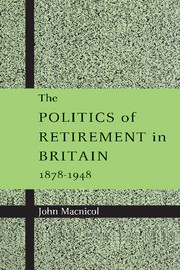Book contents
- Frontmatter
- Contents
- List of tables
- Acknowledgements
- Part I The campaign for old age pensions
- 1 Introduction
- 2 The nineteenth-century background
- 3 Blackley, Chamberlain and Booth
- 4 The opposition of the Charity Organisation Society
- 5 The attitude of the friendly societies
- 6 The labour movement and the state
- Part II Contributory pensions
- Part III The debate on retirement pensions
- Part IV The ‘Beveridge revolution’
- Index
5 - The attitude of the friendly societies
Published online by Cambridge University Press: 01 October 2009
- Frontmatter
- Contents
- List of tables
- Acknowledgements
- Part I The campaign for old age pensions
- 1 Introduction
- 2 The nineteenth-century background
- 3 Blackley, Chamberlain and Booth
- 4 The opposition of the Charity Organisation Society
- 5 The attitude of the friendly societies
- 6 The labour movement and the state
- Part II Contributory pensions
- Part III The debate on retirement pensions
- Part IV The ‘Beveridge revolution’
- Index
Summary
The friendly societies: origins and growth
Apart from the Charity Organisation Society, the other principal force opposing state old age pensions until the very end of the 1890s was the working-class friendly societies. This chapter will explore the reasons for their qualified opposition, and why they eventually came round to supporting state intervention.
The very long-term origins of friendly societies are almost ‘lost in antiquity’, as two commentators have put it. We know that guilds and craft organisations providing mutual assurance existed in Roman times; and in the reign of Edward III there was founded the St Catherine's Guild of Coventry. This latter included the provision for a member that ‘if sick, or infirm through old age, he is to be supported by his Guild according to his condition’. Moral judgements as to the applicant's character were exercised: ‘no one notorious for felony, homicide, lechery, gaming, sorcery, or heresy’ was to be admitted. In his study of the subject, Voluntary Action (1948), Lord Beveridge found several preindustrial examples, such as the Incorporation of Carters (founded in Leith in 1555), and in the medieval and early modern periods friendly societies were associated with craft guilds. A leading historian of the societies has estimated that, by the end of the eighteenth century, there must have been several thousand local small ‘box clubs’ and primitive friendly societies in Britain.
Many contingencies could be covered by a simple insurance contract between members, such as sickness, old age, loss of sight, loss of a limb, fire, flood, shipwreck, robbery, maintenance of members who travelled in search of employment (the ‘tramping artisan’), fire damage, or the loss of tools of a trade.
- Type
- Chapter
- Information
- The Politics of Retirement in Britain, 1878–1948 , pp. 112 - 136Publisher: Cambridge University PressPrint publication year: 1998



